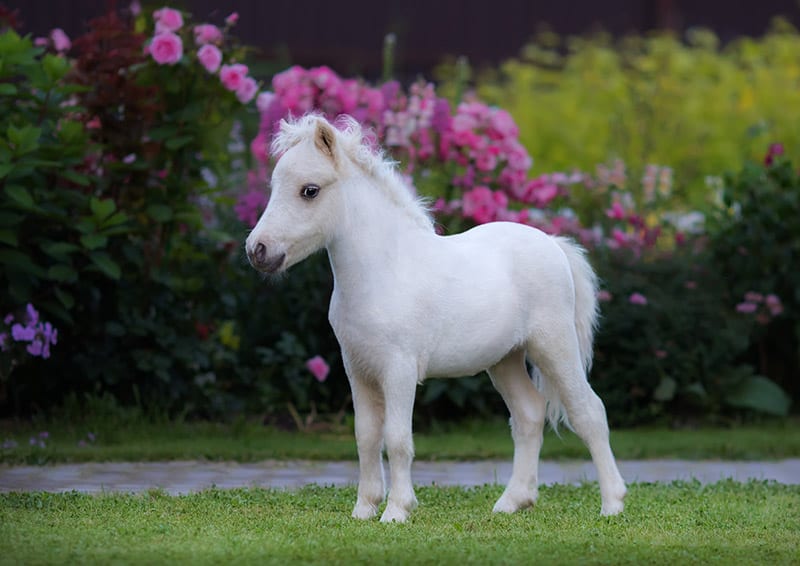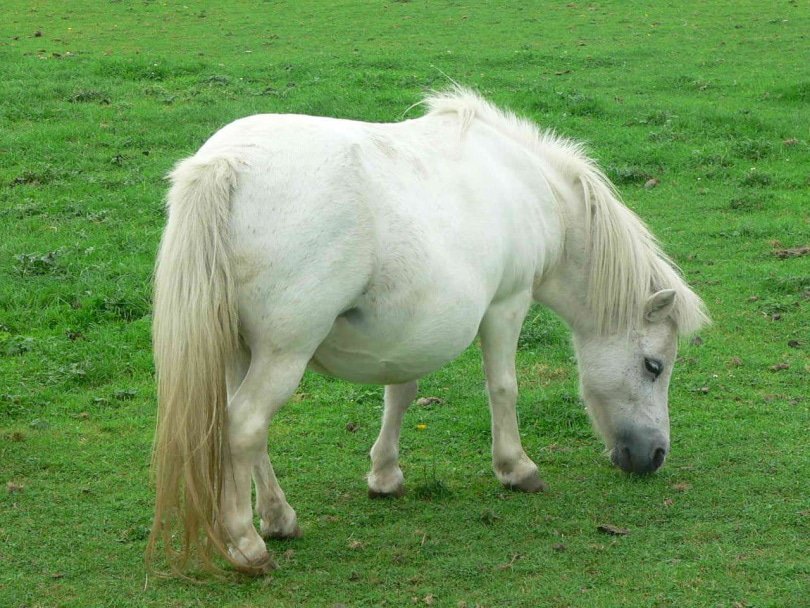A miniature horse should have the same proportions as a normal horse but be under 34 inches tall!
Miniature horses have a long history and a worldwide distribution. Their exact origins are obscure and they vary from country to country. But horses and ponies, bred-down through selective breeding techniques to become miniaturized horses, have been developed on every continent. In Europe they originated in the 17th Century, where pony breeds were bred as pets for the nobility and others were developed to work in the coal mines. The term ‘miniature horse’ encompasses all of these breeds and is considered a breed in itself. The Falabella Horses are miniature horses from Argentina, South America and are one of the smallest breeds of horse. In South Africa, there is the South African Miniature Horse that is also now recognized as a distinct breed. There is also the Caspian Horse found in the Elburz Mountains of Iran, that is also a recognized distinct breed.
In the United States Miniature horses are enjoyed for both show and as companion animals and pets. Most are too small to be ridden except by very small children, but they can be hitched to carts. Similar to highly trainable dogs, many miniature horses are also quite skilled and can be trained. They are used as guide horses to assist the blind or those with impaired hearing, while others are trained for used in military work. Also similar to dogs is their life span. A miniature horse, like a miniature dog, will live about one third longer than a full-sized horse.
There are many different breed registries across the world for miniature horses. Some registries emphasis miniatures with horse characteristics while others promote pony characteristics. There are hundreds of shows and competitions ranging from the regional stage to worldwide events. Miniature Horses can compete in all sorts of classes including everything from halter, driving, and jumping, games and obstacle courses, to conformation and showmanship.
Miniature Horses have been known by a variety of names, with the most common being the Miniature Horse, Miniature Ponies, or the Mini Horse. Some are also called Toy Horses, Pigmy Horses, and Dwarf Horses. A few other less familiar titles include Tiny Horse, Midget Horse, and Miniature Toy Horse. Generally the smallest miniature horses will be about 18 1/2 to 19 inches, but the smallest miniature on record was a stallion named ‘Little Pumpkin’ that stood only 14 inches tall.
Scientific Classification
| Kingdom: | Animalia |
| Phylum: | Chordata |
| Class: | Mammalia |
| Order: | Perissodactyla |
| Family: | Equidae |
| Genus: | Equus |
| Species: | caballus |

Horse Breeds
The Miniature Horses or Miniature Ponies should have the same proportions as a normal horse but be under 34 inches tall. They are too small to ride, but work wonderfully when hitched to a cart. They make wonderful pets, companion animals, and show animals. They can compete in everything from halter, driving, and jumping, games and obstacle courses, to conformation and showmanship.
The Mini Horse, though a bit of an odd ball, is generally considered to be a horse rather than a pony. So it is grouped with the light horses and with the ‘other’ type class.
Horse Backgrounds
The first miniature horses originated in Europe in the 17th Century from pony breeds and were bred as pets for the nobility. In the 19th Century, they were also used as work horses in Wales, the English Midlands, and Northern European coal mines as pit ponies until the 1950’s.
Around this time period, Lady Estella Hope bred miniature horses and most of the miniatures in the United States descend from the ‘Hope’ line. The breed became popular in the United States in the 20th Century. Miniature horses in the USA added additional lines from other breeds such as the Hackney Horse and the Pony of the Americas. In 1972, the Shetland Pony Registry opened a special division for miniatures and in 1978, the American Miniature Horse Association was founded.
The most well-known of the miniature breeds is the Falabella from Argentina. The Falabella Horses are descended from Andalusian horses that were brought by early Spanish immigrants and allowed to roam free. They developed characteristics that suited the sparse landscape, resulting in smaller horses. Patrick Newell began a Falabella breeding program in the late 19th Century, and by inbreeding the smallest of his stock and adding Welsh Pony and Shetland lines, he developed the smallest horse breed in the world at 30 inches tall or smaller. The smallest horse on record was a Falabella that was 20 inches tall and weighed only 30 pounds!
Another distinct miniature horse breed is the Caspian Horse. Originating from the south end of the Caspian Sea, this little horse is closely related to the Arabian, and may be the ancestor of all modern hot blooded breeds of horses.
Description
The miniature horse is a ‘height breed,’ which means that any horse under 34 inches tall is considered a miniature horse. There are some more specific miniature breeds that descend from a common bloodline, but the term ‘miniature horse’ encompasses all of these breeds and is considered a breed in itself.
A miniature horse should have the same proportions as a normal horse; the head should be in proportion with the length of the neck and the size of the body, the back should be short forming a smooth topline, and the legs should be straight. They come in all colors.

Horse Care and Feeding
Since miniature horses are much smaller than normal horses, they require much less feed. They are prone to overeating and can develop problems from too much food intake, so it is important to manage their ration to keep them at a healthy weight.
Horse Training and Activities
Miniature horses cannot be used for riding. They are great at pulling small carts and for showing in carriage and halter classes for miniatures. They also make great pets!
Common Health Problems
Miniature horses can be very expensive if they need medical treatment and responsible miniature horse owners will not buy a miniature horse unless they can afford to properly provide medical treatment.
Miniature horses are at risk for a vision-threatening disease called Anterior Segment Dysgenesis or ASD, which is a genetic disorder that seems to be linked to the chocolate (dark-chocolate silver dapple) coat color.
Breeding and Reproduction: Miniature horses tend to be at high risk for breeding problems due to their small size and the dwarf genes. Many vets consider it reckless not to have your miniature horse foal in an equine medical facility where proper medical personnel and surgical facilities are immediately available to save the life of the mare and foal.
Availability
Miniature horses are fairly available throughout most of the world.
Featured Image Credit: Piqsels
